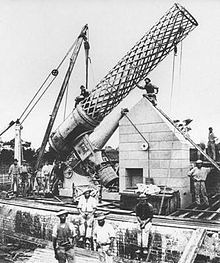Great Melbourne Telescope

The Great Melbourne Telescope being installed in 1869 after it was shipped in pieces from the works of Howard Grubb, Dublin.
|
|
| Location(s) |
Mount Stromlo Observatory |
|---|---|
| Coordinates | 37°49′47″S 144°58′34″E / 37.8297°S 144.976°ECoordinates: 37°49′47″S 144°58′34″E / 37.8297°S 144.976°E |
| Telescope style |
optical telescope |
|
|
|
|
[]
|
|
The Great Melbourne Telescope was built by Thomas Grubb in Dublin, Ireland in 1868, and installed at the Melbourne Observatory in Melbourne, Australia in 1869. In 1945 that Observatory closed and the telescope was sold and moved to the Mount Stromlo Observatory near Canberra. It was rebuilt in the late 1950s. In 2003 the telescope was practically destroyed in a severe bush fire, but a project to restore it to working condition is under way.
The telescope had a 48-inch-diameter (1,200 mm) speculum primary mirror, and was mounted on an equatorial mounting, enabling it to track the stars accurately as they appeared to move across the sky. The design had been approved by a committee of leading British astronomers and scientists. At the time of commissioning it was the second largest telescope operating in the world, after Lord Rosse’s 6 foot reflector at Birr, Ireland, and it was the largest fully steerable telescope in the world.
The telescope was designed to explore the nebulae visible from the southern hemisphere, and in particular to document whether any changes had occurred in the nebulae since they were charted by John Herschel in the 1830s at the Cape of Good Hope.
The Great Melbourne Telescope was built by Thomas Grubb in Dublin, Ireland in 1868, and installed at the Melbourne Observatory in Melbourne, Australia in 1869.
After some initial teething problems, the telescope was used for about 20 years at Melbourne Observatory, and one volume of observations produced, along with spectroscopic observations and some pioneering attempts at photographing nebulae. The telescope was upgraded with the addition of photographic equipment in 1872, but the difficulties of repolishing the mirror and the telescope’s relative unsuitability for astrophotography deterred further use.
...
Wikipedia
